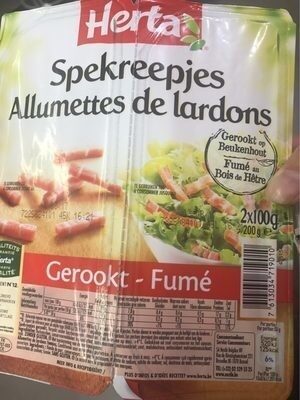Allumettes de lardon - Herta - 200 g
This product page is not complete. You can help to complete it by editing it and adding more data from the photos we have, or by taking more photos using the app for Android or iPhone/iPad. Thank you!
×
Barcode: 7613034719010 (EAN / EAN-13)
Quantity: 200 g
Packaging: Pot
Brands: Herta
Categories: Meats and their products, Prepared meats, fr:Charcuteries diverses, fr:Allumettes de porc, Lardons, Smoked lardons, Allumettes de porc, Charcuteries, Charcuteries diverses, Lardons de porc, Lardons de porc fumés, Viandes
Labels, certifications, awards: No gluten
Traceability code: FR 62.767.005 CE - Saint-Pol-sur-Ternoise (Pas-de-Calais, France)
Stores: Delhaize
Countries where sold: Belgium
Matching with your preferences
Environment
Carbon footprint
Packaging
Transportation
Report a problem
Data sources
Product added on by kiliweb
Last edit of product page on by annelotte.
Product page also edited by countrybot, date-limite-app, ecoscore-impact-estimator, feat, gluten-scan, inf, julien-b, moon-rabbit, openfoodfacts-contributors, roboto-app, yuka.WXIwbkhKMCt2ZEkzcThjQXBSZk4xODVNMjQyMWQyaWNBclZQSUE9PQ, yuka.sY2b0xO6T85zoF3NwEKvll5mcfrCkAvaaizRhmK729yLCp23OPxewJDdFqs.











